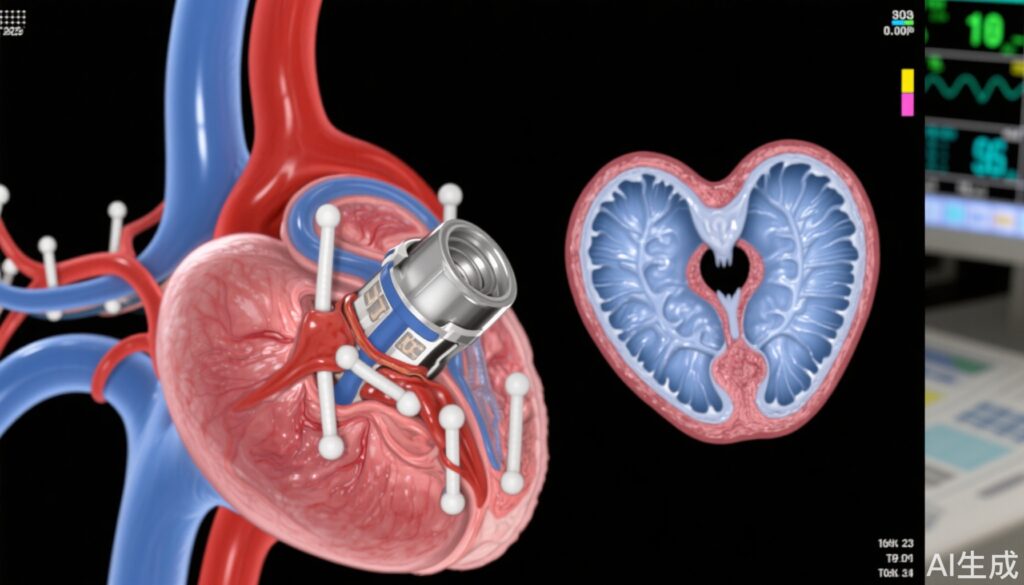Study Background and Disease Burden
Transcatheter aortic valve replacement (TAVR) has revolutionized treatment for severe aortic stenosis, a prevalent and life-threatening condition characterized by narrowing of the aortic valve. Among TAVR devices, the ACURATE neo2 valve offers a self-expanding design that aims to improve procedural safety and hemodynamics. However, the recently reported ACURATE IDE randomized controlled trial—assessing the safety and efficacy of the ACURATE neo2 valve compared with commercially established balloon-expandable (SAPIEN 3/3 Ultra) and self-expanding (Evolut R/PRO/PRO+/FX) alternatives—did not establish its noninferiority for the composite endpoint of all-cause mortality, stroke, or rehospitalization at one year. This outcome highlights a critical unmet need to understand factors influencing device performance and patient prognosis.
Study Design
The ACURATE IDE trial enrolled a main randomized cohort of 752 patients undergoing TAVR, randomized to receive the ACURATE neo2 valve or comparator devices. This post hoc analysis specifically evaluated ACURATE neo2 valve expansion by inspecting procedural angiograms reviewed by an independent core laboratory. The study aimed to detect valve underexpansion, characterized by nonparallel commissural posts, and correlate these anatomical findings with clinical outcomes. Predilation and postdilation procedural techniques, in addition to balloon sizing, were also considered to assess their potential impact on valve expansion.
Key Findings
Out of 624 patients with evaluable angiograms who received the ACURATE neo2 valve, 135 (21.6%) exhibited valve underexpansion. A critical independent predictor was greater baseline aortic valve leaflet and annulus calcification, which nearly doubled the odds of underexpansion (OR: 1.92; 95% CI: 1.27-2.91; P = 0.002). Notably, procedural approaches including predilation strategy (uniformly 100%) and postdilation frequency (roughly 26% in both groups), as well as balloon sizing, did not significantly differ between patients with underexpanded and fully expanded valves.
Clinically, valve underexpansion correlated with significantly worse 1-year outcomes: a composite of death, stroke, or rehospitalization occurred in 18.7% of underexpanded cases versus 11.8% in the expanded group (P = 0.04). Multivariable analysis confirmed that underexpansion increased the hazard of adverse events nearly twofold (HR: 1.92; 95% CI: 1.27-2.91; P = 0.002). These findings suggest that mechanical valve expansion plays an important role in long-term clinical success post-TAVR with ACURATE neo2.
Expert Commentary
These data provide mechanistic insight into why the ACURATE neo2 valve did not meet noninferiority criteria in the primary trial. Valve underexpansion likely contributes to suboptimal valve function, increased paravalvular leak, and potentially leaflet thrombosis, all of which may elevate risks of mortality and stroke. The strong association with basal calcification underscores the challenge posed by heavy aortic valve calcification—a known predictor of TAVR complications. Interestingly, procedural technique factors did not account for underexpansion, indicating that device-tissue interaction and valve design may be critical determinants.
While the analysis offers important clues, its post hoc nature mandates cautious interpretation. Larger prospective investigations and refinements in device engineering, including improved radial force and deployment mechanisms, may mitigate underexpansion risks. Additionally, tailored patient selection and angulation assessment before TAVR could optimize implantation outcomes. Current guidelines do not yet incorporate valve expansion assessment as a routine metric; however, this study advocates for incorporating imaging-based deployment quality checks.
Conclusion
Underexpansion of the ACURATE neo2 valve significantly correlates with higher incidences of death, stroke, or rehospitalization within one year after TAVR. This relationship highlights the importance of achieving optimal valve deployment to improve clinical outcomes. Although procedural factors measured did not differ, baseline calcific burden predicts underexpansion risk. Future research should focus on enhancing device design and procedural strategies to ensure optimal valve expansion and, by extension, better patient prognosis. Until such advances materialize, clinicians should be aware of this risk factor when selecting and deploying ACURATE neo2 valves.
References
Makkar RR, Chakravarty T, Gupta A, Soliman O, Gnall E, Ramana RK, Ramlawi B, Diamantouros P, Potluri S, Kleiman NS, Samy S, Rassi A, Yadav P, Thourani V, Yakubov S, Frawley C, Patel D, Kapadia S, Chalekian A, Modolo R, Sathananthan J, Kim WK, Reardon MJ. Valve Underexpansion and Clinical Outcomes With ACURATE neo2: Findings From the ACURATE IDE Trial. J Am Coll Cardiol. 2025 Jul 29;86(4):225-238. doi: 10.1016/j.jacc.2025.05.011. Epub 2025 May 21. PMID: 40406945.



